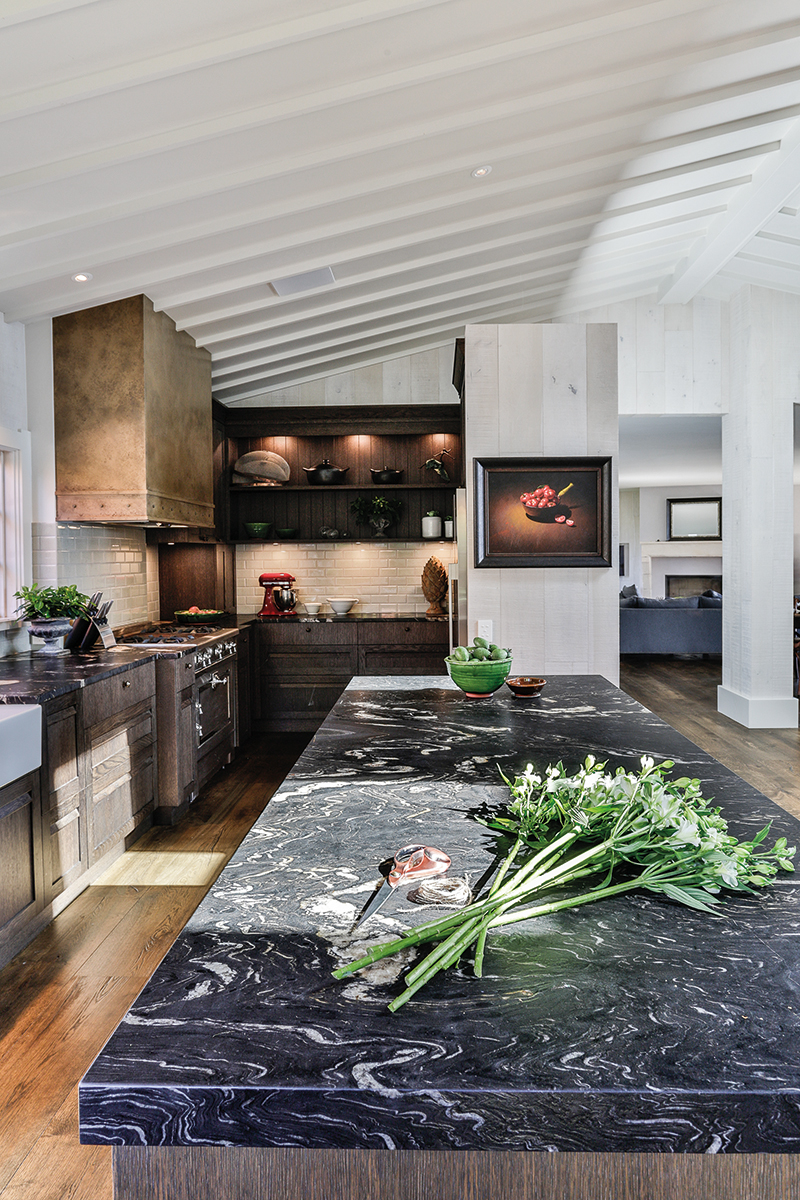The choice of benchtop can make or break your new kitchen, both in terms of looks and functionality. Jane Fergusson of Kitchens By Design take us through the options.
High-pressure porcelains are very popular because of their thin profiles and antibacterial properties. They’re also very hard-wearing and available in various finishes that accurately replicate the look of natural stone. However, they come at a higher price than other engineered products and are as costly as some granites and marbles.
There is still a big desire for natural granites and marble as they are unique natural stones that are both beautiful and eye-catching. But if the durability of porcelain appeals, then teaming them up with a natural stone feature can add that additional wow factor. The veining in natural stone can make a significant impact on the look of a kitchen.
“A beautiful, veined stone can be very striking and work well with modern or traditional kitchens,”
says Jane.
Solid surfaces are still popular, but Jane says she has not used them as much as engineered stone. The acrylics work well when a kitchen design has complex or varying shapes, or an extra-long benchtop, as the acrylic material can be joined seamlessly onsite. If scratched, they can be resurfaced. It is also an excellent material to use as bathroom vanity tops.
Stainless steel, too, has a place, and its reputation for longevity over the years has been well established. Thinner stainless tops are more on-trend, and the various finishes now available can make an incredible impact.
“Looking to the future, the addition of under-bench and in-bench technology, such as contactless phone charging, is already available in Europe, but, as yet, this has not really taken off in New Zealand,” says Jane, “mainly because of issues around warranty and appliance servicing.”
Built-in induction cooking surfaces are also available in Europe and are slowly taking off here, but could be a while off, again mainly due to warranties and reliability guarantees.
“It’s always a good idea to get the right advice on the pros and cons of a benchtop material you may be looking to use,” Jane adds. “So always ask the advice of your kitchen designer with regards to the right choice for you.”

BENCHTOP OPTIONS
High-Pressure Laminate
This is probably the most cost-effective benchtop option. Consumers also have the bonus of many brands, qualities, colourways, and patterns to choose from. Top-end examples are very durable and low maintenance and can look quite like engineered stone.
Stainless Steel
The preferred choice in commercial kitchens due to its durability, excellent antibacterial properties, heat resistance, and ease of cleaning. Reasonably priced, stainless steel benchtops are available in a range of finishes like smooth, textured, patterned, and is an excellent choice for hard-wearing family kitchens. Often stainless steel is used in the hard-working parts of the kitchen, such as sculleries and on cooktop surfaces.
Engineered Stone
For those looking for the feel of natural stone but wanting lower maintenance and a uniform appearance, engineered stone is a good option. A composite material, it’s a mix of quartz and a resin compound formed under high pressure, making it strong, durable, and impact resistant.
Engineered stone comes in myriad colours and patterns to suit traditional and contemporary looks and is often more cost-effective option than natural stone.
Acrylic
This type of benchtop is comparably priced to engineered stone. The advantage with acrylic is that there are no visible joins, which is excellent for long benchtops, curves and creative designs. Plain white acrylics are generally at the cheaper end of the scale, while those with graining or textures are more costly. They can also be repaired and re-polished when necessary. Beware, these surfaces are vulnerable to direct, intense heat, such as a hot pan straight off the hob.
High-Pressure Porcelain
The new kid on the block – and a very impressive benchtop material. Made from all-natural compressed porcelain and available in large-format slabs, it’s practically impervious to damage, doesn’t stain, doesn’t scratch, and is UV stable, so can even be used outdoors. Because it’s so strong, it can be produced in thinner profiles than other materials, making it ideal for modern designs.
Natural Stone
Granite and marble are still the most common types of stone for benchtops. Granite is superior for strength and durability, while ‘softer’ marble is typically the more expensive of the two. Because both are natural, they have variations in colour and texture. Each slab is unique, which adds a strong sense of authenticity to a kitchen, with different stones bringing their own aesthetic and physical properties. Limestone, marble, granite and quartzite get progressively more robust in that order. Most natural stone also requires regular resealing to maintain appearance.
Timber
Mainly used in conjunction with more traditional kitchen designs and chosen by those who love its warm aesthetic and soft touch, timber is still a popular choice. Timber benchtops require regular resealing and are less resistant to scratches, dents, and staining; therefore, they need more care to keep them looking their best.
So, there you have it – some top advice from one of the country’s best kitchen designers. If you’re looking to put in a new kitchen, pop into Kitchens By Design’s showroom at 3 Byron Ave in Takapuna, or call on (09) 379 3084. For inspiration, take a look at some fabulous projects at kitchensbydesign.co.nz






